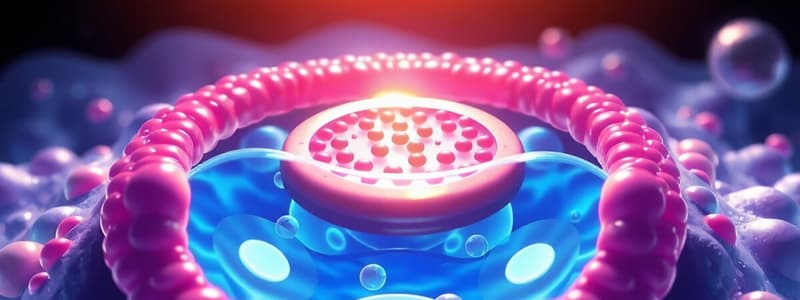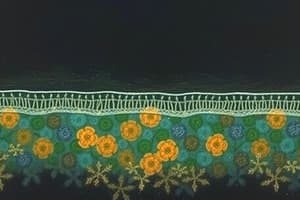Podcast
Questions and Answers
What structure is primarily responsible for the cell membrane's selective permeability?
What structure is primarily responsible for the cell membrane's selective permeability?
- Phosphate heads
- Phospholipid bilayer (correct)
- Lipid tails
- Membrane proteins
In the fluid mosaic model, what does the term 'fluid' refer to?
In the fluid mosaic model, what does the term 'fluid' refer to?
- The static nature of the cell membrane
- The dynamic and flexible characteristics of membrane components (correct)
- The rigid components of the membrane
- The presence of water in the membrane
What is the main effect of placing a cell in a hypertonic solution?
What is the main effect of placing a cell in a hypertonic solution?
- The cell will swell
- The cell will shrivel due to water loss (correct)
- Water will move into the cell
- The cell will remain unchanged
How does osmosis differ from diffusion?
How does osmosis differ from diffusion?
What is likely to happen to a cell placed in a hypotonic solution?
What is likely to happen to a cell placed in a hypotonic solution?
Which type of solution results in equal concentrations of solutes inside and outside the cell?
Which type of solution results in equal concentrations of solutes inside and outside the cell?
What defines facilitated diffusion compared to simple diffusion?
What defines facilitated diffusion compared to simple diffusion?
Why do phosphate heads of phospholipids orient themselves towards water?
Why do phosphate heads of phospholipids orient themselves towards water?
What happens to water movement when a cell is placed in a hypertonic environment?
What happens to water movement when a cell is placed in a hypertonic environment?
What characterizes a semipermeable membrane?
What characterizes a semipermeable membrane?
What is the primary characteristic of the lipid tails in the phospholipid bilayer?
What is the primary characteristic of the lipid tails in the phospholipid bilayer?
What occurs when a cell in a hypertonic solution loses water?
What occurs when a cell in a hypertonic solution loses water?
Which of the following accurately describes osmosis?
Which of the following accurately describes osmosis?
How would a cell respond in a hypotonic environment?
How would a cell respond in a hypotonic environment?
What does the term 'isotonic' indicate about a solution in relation to a cell?
What does the term 'isotonic' indicate about a solution in relation to a cell?
What role do phosphate heads play in the structure of cell membranes?
What role do phosphate heads play in the structure of cell membranes?
How do facilitated diffusion and simple diffusion primarily differ?
How do facilitated diffusion and simple diffusion primarily differ?
What is the function of the semipermeable nature of cell membranes?
What is the function of the semipermeable nature of cell membranes?
What accurately describes the term 'fluid' in the fluid mosaic model?
What accurately describes the term 'fluid' in the fluid mosaic model?
Which factor can influence the movement of water across a semipermeable membrane?
Which factor can influence the movement of water across a semipermeable membrane?
Flashcards
Phospholipid Bilayer
Phospholipid Bilayer
The cell membrane is composed of lipids and proteins that separate the cell's contents from the outside world. It's called a "bi-layer" because it has two layers of phospholipids arranged with their heads facing each other.
Phosphate Heads
Phosphate Heads
The phosphate heads of phospholipids are hydrophilic, meaning they like water and orient themselves towards it.
Lipid Tails
Lipid Tails
The lipid tails of phospholipids are hydrophobic, meaning they fear water and face away from it.
Fluid Mosaic Model
Fluid Mosaic Model
Signup and view all the flashcards
Semipermeable Membrane
Semipermeable Membrane
Signup and view all the flashcards
Diffusion
Diffusion
Signup and view all the flashcards
Osmosis
Osmosis
Signup and view all the flashcards
Hypertonic Solution
Hypertonic Solution
Signup and view all the flashcards
Hypotonic Solution
Hypotonic Solution
Signup and view all the flashcards
Isotonic Solution
Isotonic Solution
Signup and view all the flashcards
What is diffusion?
What is diffusion?
Signup and view all the flashcards
What is osmosis?
What is osmosis?
Signup and view all the flashcards
Why does water move in osmosis?
Why does water move in osmosis?
Signup and view all the flashcards
What is a hypertonic solution?
What is a hypertonic solution?
Signup and view all the flashcards
What is a hypotonic solution?
What is a hypotonic solution?
Signup and view all the flashcards
What is an isotonic solution?
What is an isotonic solution?
Signup and view all the flashcards
What is facilitated diffusion?
What is facilitated diffusion?
Signup and view all the flashcards
Why is the cell membrane called a phospholipid bilayer?
Why is the cell membrane called a phospholipid bilayer?
Signup and view all the flashcards
What are phosphate heads in the cell membrane?
What are phosphate heads in the cell membrane?
Signup and view all the flashcards
What are lipid tails in the cell membrane?
What are lipid tails in the cell membrane?
Signup and view all the flashcards
Study Notes
Cell Membrane Structure
- The cell membrane is composed of lipids and proteins, separating the cell's contents from the external environment.
- It's a bilayer, consisting of two layers of phospholipids.
- Phospholipid heads are hydrophilic (water-loving), positioning themselves towards the watery environment.
- Phospholipid tails are hydrophobic (water-fearing), aligning away from the water.
- The fluid mosaic model describes the cell membrane's structure, emphasizing fluidity and a mosaic pattern of embedded proteins.
Membrane Permeability
- Cell membranes are semipermeable.
- This means they control what substances pass through, selectively allowing specific molecules and substances to enter or exit.
Movement Across Membranes
- Diffusion: The movement of liquid or gas molecules from a region of higher concentration to one of lower concentration across a membrane.
- Osmosis: The diffusion of water across a semipermeable membrane. Water movement is influenced by solute concentration.
- Hypertonic Solution: A solution with a higher solute concentration outside the cell than inside. Water exits the cell, leading to cell shrinkage or plasmolysis.
- Hypotonic Solution: A solution with a lower solute concentration outside the cell compared to inside. Water enters the cell, potentially causing cell swelling or lysis.
- Isotonic Solution: A solution maintains the same solute concentration inside and outside the cell; optimal for cell balance and health.
Facilitated Diffusion
- Facilitated diffusion is a passive transport mechanism.
- Carrier proteins aid in the movement of molecules across the membrane without energy input.
- The shape of protein carriers changes during the passage of molecules.
Active Transport
- Active transport requires energy (ATP).
- Molecules move against the concentration gradient (from low to high concentration).
- The sodium-potassium pump is an example of active transport and plays important roles in nerve impulse transmission and muscle contraction.
Bulk Transport
- Bulk transport involves the movement of large molecules.
- Exocytosis: Materials exit the cell, often through vesicle fusion with the membrane.
- Endocytosis: Materials enter the cell, enclosing the substance in a vesicle that pinches off.
- Receptor-mediated Endocytosis: Specific molecules are targeted for uptake by cell-surface receptors, concentrating and facilitating the entry of those molecules into the cell.
Studying That Suits You
Use AI to generate personalized quizzes and flashcards to suit your learning preferences.




